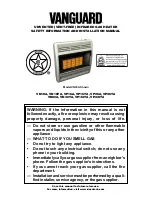
17
10.
Water Piping
This appliance is suitable for potable water. Do not use this appliance if any part has been underwater. Immediately
call a qualified service technician to inspect the appliance and replace any part of the control system and gas control
which has been under water.
If the water heater is installed in a closed water supply system, such as one having a backflow preventer in the cold
water supply line, means shall be provided to control thermal expansion. Contact ANDREWS WATER HEATERS
TECHNICAL DEPARTMENT FOR ADVICE.
Piping and components connected to the water heater shall be suitable for use with potable water.
Toxic chemicals, such as those used for boiler treatment, shall not be introduced into the potable water.
A water heater used to supply potable water may not be connected to any heating system or components previously
used with a nonpotable water heating appliance.
When water is required in one part of the system at a higher temperature than in the rest of the system, means such
as a mixing valve shall be installed to temper the water to reduce the scalding hazard.
• Flush water through the pipe to clean out metal powder, sand and dirt before connecting it.
• Take appropriate heat insulation measures (e.g., wrapping with heat insulation materials, using electric heaters)
according to the climate of the region to prevent the pipe from freezing.
• Use a union coupling or flexible pipe for connecting the pipes to reduce the force applied to the piping.
• Do not use piping with a diameter smaller than the coupling.
• When feed water pressure is too high, insert a depressurizing valve, or take water hammer prevention measures.
• Avoid using joints as much as possible to keep the piping simple.
• Avoid piping in which an air holdup can occur.
• Use approved piping materials.
• If installing the unit on a roof:
If the unit is installed on a roof to supply water to the levels below, make sure that the water pressure supplied to
the unit does not drop below 2000 mbar. It may be necessary to install a pump system to ensure that the water
pressure is maintained at this level.
Check the pressure before putting the unit into operation.
Failing to supply the proper pressure to the unit may result in noisy operation, shorter lifetime of the unit, and
may cause the unit to shut down frequently.
Supply water piping
• Do not use PVC piping.
• Mount a check valve and a shut off valve (near
the inlet).
• In order for the client to use the water heater
comfortably,1000 mbar to 5000 mbar of pres-
sure is needed from the water supply.
Be sure to check the water pressure. If the water
pressure is low, the water heater cannot perform
to its full capability, and may become a source of
trouble for the client.
Drain piping
• Expansion water may drop from the pressure
prevention device and wet the floor. If neces-
sary, provide drain piping or use a drain hose to
remove the water.
Hot water piping
• Do not use lead or PVC piping.
• The longer the piping, the greater the heat loss.
Try to make the piping as short as possible.
• Use a mixing valve with a low water resistance.
Use shower heads with low pressure loss.
• If necessary, use a pump or other means to en-
sure that the supply water pressure to the inlet
of the heater does not fall below
2000 mbar
when
the maximum amount of water is being de-
manded. Also install a pressure meter on the in-
let. If this is not done, local boiling will occur in-
side the water heater causing abnormal sounds
and decreasing the durability of the heat ex-
changer.
Ask a qualified plumber to perform the installation
of the plumbing. Observe all applicable codes.
(L)WH42̲56(16̲24)̲E
05.9.26, 7:41 PM
Page 17
Adobe PageMaker 6.5J/PPC
















































